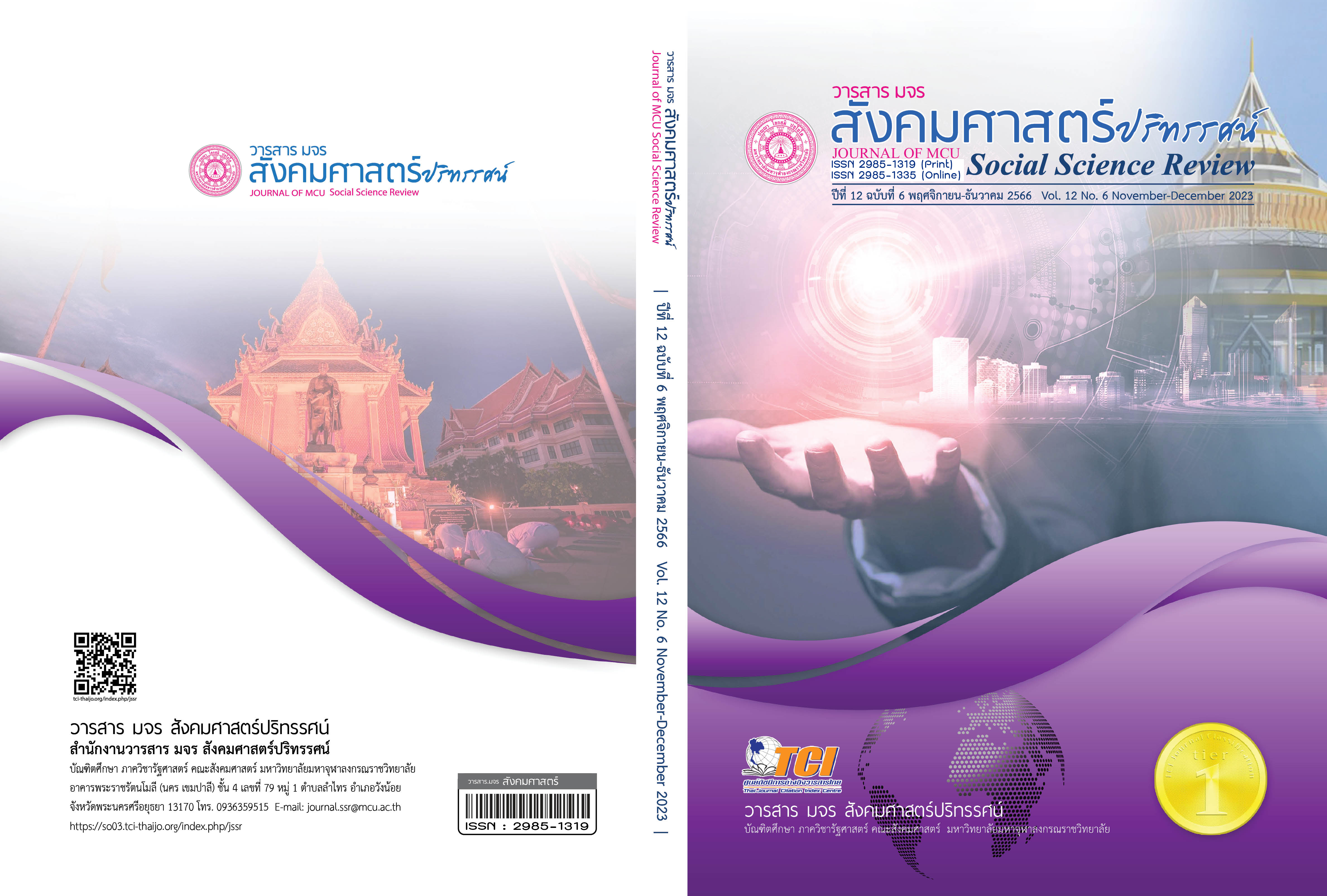ศักยภาพของชุมชนที่เข้าร่วมโครงการมหาวิทยาลัยสู่ตำบล สร้างรากแก้วให้ประเทศต่อผลสัมฤทธิ์ตามแผนการพัฒนาชุมชนในจังหวัดขอนแก่น
คำสำคัญ:
มหาวิทยาลัยสู่ตำบล, ศักยภาพชุมชน, เศรษฐกิจฐานราก, แผนพัฒนาชุมชน, การพัฒนาทักษะใหม่บทคัดย่อ
บทความวิจัยนี้มีวัตถุประสงค์ 1. ศึกษาศักยภาพในภาพรวมของแต่ละตำบล ในจังหวัดขอนแก่นที่เข้าร่วมโครงการ U2T ในเชิงองค์ประกอบชี้นำความพร้อมขององค์กรชุมชนต่อการปรับตัว และในเชิงองค์ประกอบชี้นำความพร้อมต่อการดำเนินการให้เป็นไปตามแผนงาน และ
2. เพื่อจัดลำดับศักยภาพของชุมชนที่เข้าร่วมโครงการ U2T ใช้ระเบียบวิธีวิจัยเชิงปริมาณ เครื่องมือที่ใช้คือ แบบสอบถาม ทำการสุ่มแบบเจาะจงและเก็บข้อมูลจากผู้เข้าร่วมโครงการ วิเคราะห์ข้อมูลด้วยวิธีวิเคราะห์เนื้อหา มีตัวแทนประชากรจำนวนรวม 252 คน โดยพิจารณาจาก 1) การวิเคราะห์องค์ประกอบชี้นำความพร้อมขององค์กรชุมชนต่อการปรับตัวและ 2) การวิเคราะห์องค์ประกอบชี้นำความพร้อมต่อการดำเนินการให้เป็นไปตามแผนงานของโครงการ ผลการศึกษาจำแนกเครือข่ายที่มีศักยภาพออกเป็น 3 ระดับ ระดับสูง ระดับปานกลาง และระดับศักยภาพขั้นพื้นฐานหรือระดับต่ำ
ผลการวิจัยพบว่า 1. ศักยภาพของชุมชนที่เข้าร่วมโครงการ U2T ในจังหวัดขอนแก่นในระดับที่สูงได้แก่ ตำบลโนนแดง ตำบลในเมือง ตำบลกุดกว้าง รองลงมาได้แก่ ตำบลตะกั่วป่า ตำบลหนองเรือ และ 2. ศักยภาพความพร้อมของชุมชนระดับต่ำ ได้แก่ ตำบลก้านเหลือง ตำบลหนองตูม และตำบลบัวใหญ่ เหตุและปัจจัยสำคัญมาจาก กระบวนการมีส่วนร่วมตั้งแต่ต้นจนจบโครงการ ความเข้าใจในแผนแต่ละขั้นตอน จำนวนสมาชิกที่เข้าร่วมโครงการ และจำนวนเครือข่ายความร่วมมือภายในพื้นที่ ผลการศึกษาสามารถนำไปใช้ในการวางแผนและพัฒนาชุมชนเพื่อพัฒนาเศรษฐกิจฐานรากและการพัฒนาชุมชนอย่างยั่งยืน
เอกสารอ้างอิง
Samart, P. (2021). การสำรวจการปรับตัวของชุมชนวิถี ใหม่ในสถานการณ์การระบาดของโรค โควิด-19 จังหวัดนครนายก. Research Journal Phranakhon Rajabhat: Social Sciences and Humanity, 16(2), 52-71.
ประถม ศิริวงศ์วานงาม และศรัณย์ ธิติลักษณ์. (2022). การพัฒนาเศรษฐกิจชุมชนในภาคเหนือตอนบนของไทย: ศักยภาพและ บทบาทของชุมชนและรัฐในการพัฒนา. วารสารสันติ ศึกษาปริทรรศน์ มจร, 10(1), 227-239.
มหาวิทยาลัยขอนแก่น. (2565). รายงานผลการดำเนินงานโครงการยกระดับเศรษฐกิจและสังคมรายตำบลแบบบูรณาการ (U2T) ระยะที่ 1. สืบค้นเมื่อ 18 ธันวาคม 2565, จาก https://th.kku.ac.th/91791/
อาณัติ ลีมัคเดช. (2016). จัดทำระบบฐานข้อมูล ผลการดำเนินงาน ตามแผนยุทธศาสตร์และแผนปฏิบัติราชการ. ปทุมธานี: มหาวิทยาลัยธรรมศาสตร์.
Alexander, E. R., & Faludi, A. (1989). Planning and plan implementation: notes on evaluation criteria. Environment and planning B: Planning and Design, 16(2), 127-140.
Berke, P., et al. (2006). What makes plan implementation successful? An evaluation of local plans and implementation practices in New Zealand. Environment and Planning B: Planning and Design, 33(4), 581-600.
DeFilippis, J., et al., (2010). Contesting community: The limits and potential of local organizing. Rutgers University Press.
Long, D., & Fox, M. (1999). Efficient implementation of the plan graph in STAN. Journal of Artificial Intelligence Research, 10, 87-115.
Lyles, W., et al. (2016). Local plan implementation: Assessing conformance and influence of local plans in the United States. Environment and Planning B: Planning and Design, 43(2), 381-400.
Noddings, N. (1996). On community. Educational theory, 46(3), 245-267.
ดาวน์โหลด
เผยแพร่แล้ว
รูปแบบการอ้างอิง
ฉบับ
ประเภทบทความ
สัญญาอนุญาต
ลิขสิทธิ์ (c) 2023 วารสาร มจร สังคมศาสตร์ปริทรรศน์

อนุญาตภายใต้เงื่อนไข Creative Commons Attribution-NonCommercial-NoDerivatives 4.0 International License.
เพื่อให้เป็นไปตามกฎหมายลิขสิทธิ์ ผู้นิพนธ์ทุกท่านต้องลงลายมือชื่อในแบบฟอร์มใบมอบลิขสิทธิ์บทความให้แก่วารสารฯ พร้อมกับบทความต้นฉบับที่ได้แก้ไขครั้งสุดท้าย นอกจากนี้ ผู้นิพนธ์ทุกท่านต้องยืนยันว่าบทความต้นฉบับที่ส่งมาตีพิมพ์นั้น ได้ส่งมาตีพิมพ์เฉพาะในวารสาร มจร สังคมศาสตร์ปริทรรศน์ เพียงแห่งเดียวเท่านั้น หากมีการใช้ภาพหรือตารางหรือเนื้อหาอื่นๆ ของผู้นิพนธ์อื่นที่ปรากฏในสิ่งตีพิมพ์อื่นมาแล้ว ผู้นิพนธ์ต้องขออนุญาตเจ้าของลิขสิทธิ์ก่อน พร้อมทั้งแสดงหนังสือที่ได้รับการยินยอมต่อบรรณาธิการ ก่อนที่บทความจะได้รับการตีพิมพ์ หากไม่เป็นไปตามข้อกำหนดเบื้องต้น ทางวารสารจะถอดบทความของท่านออกโดยไม่มีข้อยกเว้นใดๆ ทั้งสิ้น





